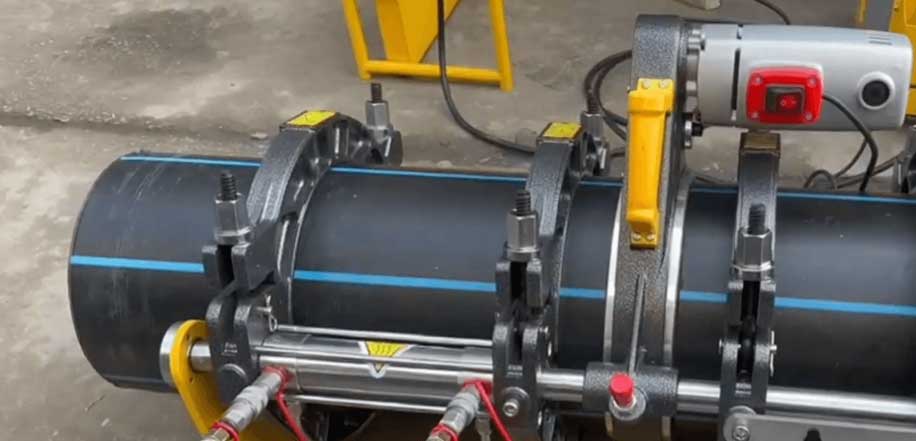Butt Fusion – Polyethylene Welding
Butt Fusion Welding is a common method for joining plastic pipes. Widely used in various industries such as water distribution, gas supply, and agriculture, this technique creates strong, leak-free connections.
Steps in Butt Fusion Welding
- Pipe Preparation:
- The pipe ends must be completely clean and free from contaminants, dust, or grease.
- Pipes are aligned and adjusted carefully to ensure they are in a straight line.
- Precise Cutting of Pipe Ends:
- Special tools (such as scrapers or cutting devices) are used to make precise cuts, ensuring flat and aligned pipe ends.
- Heating the Pipe Ends:
- A heated plate with a controlled temperature is placed between the pipe ends.
- The pipe ends are heated until the plastic material softens and begins to melt.
- Removing the Heater Plate:
- Once the required temperature is achieved, the heater plate is removed, and the pipe ends are immediately pressed together.
- Joining and Cooling:
- Appropriate pressure is applied to press the pipe ends together, maintaining the connection until the material cools.
- This results in a strong, homogeneous joint.
Advantages of Butt Fusion Welding
- High Strength: The joint is as strong as the pipe itself.
- Leak-Proof: The homogeneous nature of the joint eliminates leak risks.
- Durability: Resistant to pressure, corrosion, and temperature variations.
- Eco-Friendly: No adhesives or chemicals are used.
Applications
- Potable water pipelines
- Gas distribution systems
- Sewage lines
- Industrial and agricultural systems
Safety and Technical Guidelines
- Use appropriate and precise equipment.
- Control the temperature of the heater plate to prevent overheating or over-melting.
- Maintain uniform pressure throughout the joining process.
- Ensure operators are fully trained to guarantee welding quality.
Tools and Equipment for Butt Fusion Welding
- Butt Fusion Welding Machine:
- Includes a clamping system for holding and aligning pipes, a heating plate, and a pressure control unit.
- Some machines feature advanced temperature and pressure control systems.
- Heater Plate:
- Responsible for heating the pipe surfaces.
- Should have a non-stick coating and maintain uniform temperature.
- Scraper or Cutter:
- Used to smooth and align the pipe ends before welding.
- Precise scraping is critical for final weld quality.
- Alignment Tools and Clamps:
- Hold the pipes in place and ensure proper alignment.
- Clamps should be firm yet gentle to avoid damaging the pipe.
- Thermometer or Temperature Control System:
- Monitors and regulates the heater plate temperature.
- Cooling Devices (Optional):
- In some cases, used to speed up the cooling process and reduce operation time.
Factors Affecting Welding Quality
- Proper Temperature:
- The heater plate temperature must match the plastic material type (e.g., polyethylene or PVC).
- Standard temperatures usually range from 200 to 240°C.
- Pressure:
- Applied pressure during the process must be carefully controlled. Excessive or insufficient pressure can result in joint defects.
- Timing:
- Heating and pressing times should be precisely adjusted depending on pipe diameter and material.
- Clean Surfaces:
- Any contamination or moisture can weaken the joint.
- Accurate Alignment:
- Misaligned pipes can lead to weak and uneven joints.
Common Defects in Butt Fusion Welding and Solutions
- Weak or Incomplete Joints:
- Cause: Insufficient pressure or inadequate heating time.
- Solution: Adjust pressure and timing properly.
- Over-Melting:
- Cause: Excessively high heater plate temperature.
- Solution: Monitor and control the temperature settings.
- Bubbles or Cracks:
- Cause: Contaminants or moisture on pipe surfaces.
- Solution: Thoroughly clean the pipe ends before welding.
- Misalignment:
- Cause: Improper adjustment of pipes in the machine.
- Solution: Use precise alignment tools.
Standards and Certifications in Butt Fusion Welding
To ensure quality and safety in welded joints, adherence to recognized standards is essential. Key standards include:
- ISO 21307: International standard for polyethylene pipe welding.
- ASTM F2620: Standard practice for butt fusion welding procedures.
- DVS 2207: German standard for plastic pipe welding.
Operators should also receive appropriate welding training and possess valid certifications.

